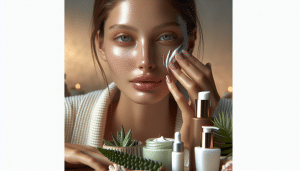Skin Barrier Repair Strategies You Might Overlook
Natalie Brooks September 4, 2025
Many are unaware of the essential link between a strong skin barrier and lasting beauty. This guide explores low-profile strategies, ingredient trends, and expert dermatologist insights that help nurture a resilient complexion—so you can learn more and explore what truly matters for healthy skin.
The Science Behind the Skin Barrier
The skin barrier, or stratum corneum, is the first line of defense that keeps moisture in and harmful elements out. This outer layer consists of corneocytes embedded in a lipid matrix, forming a natural shield against pollution and pathogens. It’s not just a static shield; it is constantly in a state of renewal and repair. Many quietly struggle with invisible skin barrier disruption, leading to dryness, heightened sensitivity, and persistent redness. Research highlights that maintaining this protective layer is foundational for lasting skin health and beautiful appearance (https://www.ncbi.nlm.nih.gov/pmc/articles/PMC5843358/).
Environmental stressors complicate matters. Everyday exposure to UV rays, air pollution, and even common soaps can compromise skin barrier function. This breakdown allows irritants to penetrate deeper, causing inflammation, dehydration, and sometimes allergic reactions. Science has clearly shown that a weakened barrier increases the risk of chronic skin conditions, making restoration and protection vitally important. Embracing barrier repair can change how skin ages and how it looks on a daily basis.
Genetic and lifestyle factors also come into play with skin barrier health. A balanced diet rich in antioxidants, sufficient hydration, and even restful sleep all contribute to an optimal environment for repair. Understanding these influences helps shape choices—both at the vanity and in the kitchen. With knowledge about the fundamental science supporting the skin barrier, it becomes easier to prioritize habits and products that nurture skin from the inside out.
Recognizing Signs of Barrier Disruption
Barrier dysfunction isn’t always obvious. People may notice increased dryness, stinging after applying lotions, or sudden outbreaks of redness and rough patches. These cues can be subtle at first, then grow more disruptive if the underlying issue remains unaddressed. Specialists often suggest paying attention to persistent flakiness or a tight feeling after washing, which are classic signs that the skin’s outermost layer has been compromised (https://www.aad.org/public/diseases/a-z/skin-barrier).
Aging naturally affects barrier strength and recovery. With time, the skin produces less sebum and cell turnover slows down, leaving the epidermis more vulnerable. Lifestyle factors, including frequent exfoliation or harsh cleansers, can compound this vulnerability. Many aren’t aware that the skin needs time to rebalance, especially after procedures or active ingredients. Noticing recurring irritation or dullness may signal the need for a gentler approach and targeted barrier-boosting practices.
Itching, burning, or the sudden appearance of fine lines are sometimes overlooked as barrier-related symptoms. Many believe these sensations are a temporary reaction, but prolonged symptoms may require a change in daily care. Choosing fragrance-free and hypoallergenic products, as well as decreasing reliance on exfoliants, are common recommendations for those experiencing chronic sensitivity.
Key Ingredients for Repairing and Strengthening
Several powerhouse ingredients have become mainstays for skin barrier support. Ceramides, naturally occurring lipids, help fill the spaces between skin cells and maintain resilience. Dermatologists consistently recommend them, especially following sun exposure or cleansing routines. Niacinamide, another popular choice, provides anti-inflammatory benefits alongside barrier reinforcement, making it a multipurpose wonder in modern skincare (https://www.ncbi.nlm.nih.gov/pmc/articles/PMC8536775/).
Fatty acids and cholesterol are equally vital for restoring balance. Products featuring natural oils, such as jojoba or squalane, can supplement the skin’s own lipid production. Research shows that including these ingredients in moisturizers helps speed up recovery from environmental assaults. Additionally, ingredients like panthenol and glycerin attract and hold moisture, ensuring newly repaired skin remains hydrated and supple.
Oat extract, madecassic acid, and allantoin have also gained traction for their soothing, reparative properties. Various clinical studies support their effectiveness in reducing redness and supporting recovery in sensitive skin populations. Some opt for simple formulations free from dyes and fragrances, focusing on ingredient lists where each item contributes directly to barrier repair and calmness. Exploring options with these actives offers promising pathways to healthier skin for many.
Daily Habits That Support a Healthier Skin Barrier
Cleansing gently is often overlooked in barrier care. Instead of aggressive scrubbing or frequent washing, dermatologists suggest lukewarm water and sulfate-free cleansers that preserve the skin’s natural oils. Over-cleansing strips away essential lipids, setting off a cycle of dryness and irritation. Incorporating a double-cleansing method in the evening can remove sunscreen and makeup while still protecting the protective barrier (https://www.clevelandclinic.org/health/articles/22315-skin-barrier-protection).
Applying moisturizer immediately after showering or cleansing is a proven way to trap hydration. This technique, known as “moisture sandwiching,” helps reinforce the barrier and maximizes the benefits of occlusives and humectants. Many find that layering products, beginning with hydrating toners and sealing with ointments, leads to visible improvements over time. Picking a formula tailored for sensitive or weakened skin makes a meaningful difference.
Protective habits matter just as much as the products used. Limiting hot showers, wearing SPF year-round, and shielding the face from wind are practical steps anyone can take. These routines, combined with stress management and good nutrition, ensure a multifaceted approach to barrier maintenance. Practicing gentle self-care helps foster a soothing skin environment, no matter the season or lifestyle.
Emerging Trends in Skin Barrier Research
Recent research has uncovered fascinating links between the microbiome and skin barrier function. Beneficial microbes living on the skin appear to communicate directly with the immune system, helping regulate inflammation and repair. As prebiotic and probiotic skincare becomes more mainstream, more are curious about how to cultivate a balanced microbiome for long-term resilience (https://www.ncbi.nlm.nih.gov/pmc/articles/PMC7333133/).
Personalized skincare is also gaining traction. Technology now allows for genetic and microbiome testing that informs ingredient choices and routines suited to individual needs. Dermatologists recommend starting with patch testing and noting small improvements, as skin’s response can vary widely. Delving into genetic predispositions can clarify why some experience constant sensitivity—even with the same products as others.
Another exciting development is the rise of barrier recovery “boosters.” Concentrated serums and overnight masks featuring lipids, peptides, and up-and-coming botanical ingredients promise a new era in recovery speed. While early studies show promise, experts advise integrating these slowly and observing for adverse effects. Keeping informed about these advancements gives enthusiasts a chance to make smart, evidence-based choices for their skin future.
When to Consult a Specialist for Skin Barrier Issues
For many, self-directed care brings significant improvements. However, some situations require professional guidance. Persistent rashes, peeling, or stinging that does not resolve may indicate underlying conditions like eczema, contact dermatitis, or allergic reactions. Dermatologists use non-invasive imaging and patch testing to diagnose complex cases and recommend targeted therapies (https://www.dermnetnz.org/topics/skin-barrier-function).
Some individuals may unintentionally worsen symptoms with certain treatments or home remedies. Overuse of acids, retinoids, or essential oils can reveal patterns of damage best evaluated with medical oversight. In these cases, a dermatologist may recommend prescription creams, oral medications, or a customized routine to restore comfort. Approaching barrier health collaboratively often improves both skin appearance and patient confidence.
Early intervention is key to reversing long-term disruption. Waiting can complicate recovery, especially when infection risk or widespread irritation develops. Consulting a professional not only provides clarity but also unlocks access to advanced treatments. With the support of knowledgeable specialists, regaining and maintaining a resilient skin barrier becomes a practical and achievable goal.
References
1. Denda, M. (2018). Skin Barrier Function and Its Importance. Retrieved from https://www.ncbi.nlm.nih.gov/pmc/articles/PMC5843358/
2. American Academy of Dermatology Association. (n.d.). Skin barrier: What it is & how to care for it. Retrieved from https://www.aad.org/public/diseases/a-z/skin-barrier
3. Chen, Y., Lyga, J. (2021). Niacinamide and Its Multifaceted Effects on Skin. Retrieved from https://www.ncbi.nlm.nih.gov/pmc/articles/PMC8536775/
4. Cleveland Clinic. (n.d.). Protect Your Skin Barrier: Tips to keep it strong and healthy. Retrieved from https://www.clevelandclinic.org/health/articles/22315-skin-barrier-protection
5. Biedermann, T., Skabytska, Y., Kaesler, S., Volz, T. (2020). The Role of the Skin Microbiome in the Skin Barrier Function. Retrieved from https://www.ncbi.nlm.nih.gov/pmc/articles/PMC7333133/
6. DermNet NZ. (n.d.). Skin barrier function. Retrieved from https://www.dermnetnz.org/topics/skin-barrier-function








